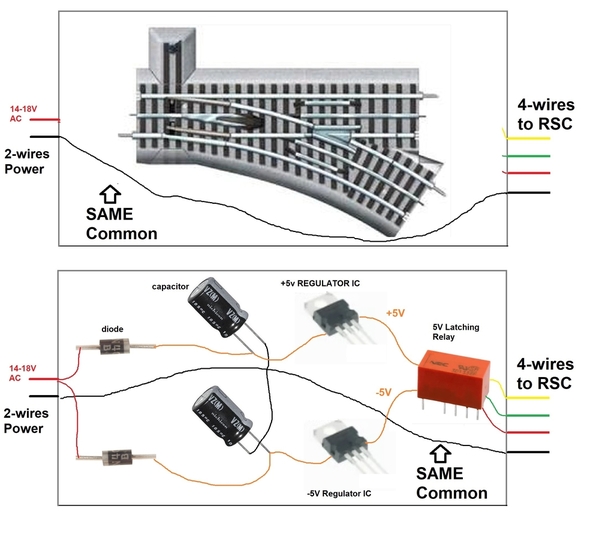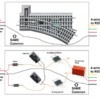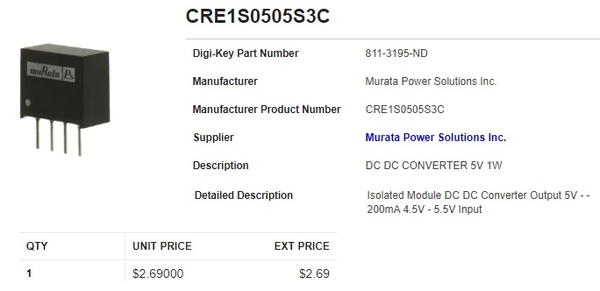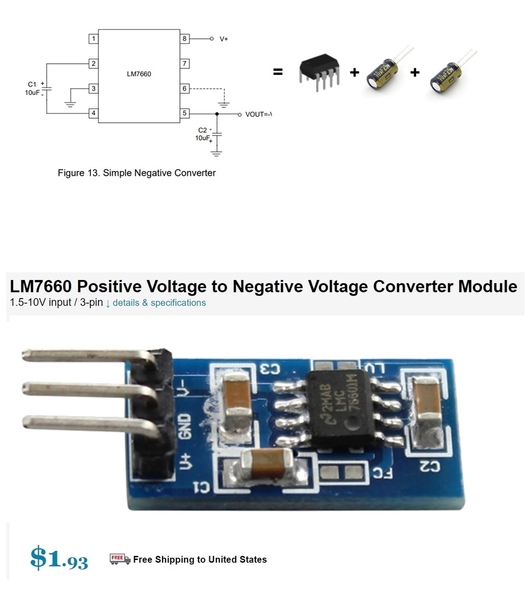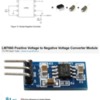Well, I'm not normally at Henning's, just go there to drop of repairs and products and hopefully pick up checks. ![]() But you could come visit me at my place, I'm close to Henning's.
But you could come visit me at my place, I'm close to Henning's. ![]()
Will do. Never been to Hennings, Nicholas Smith gets most of my money :-)
Bring some money to Henning's, I need them to stay healthy so my products sell! ![]()
![]()
@SteveH posted:EDIT: I originally thought that a Latching Dual Coil DPTD circuit using a single 5VDC power supply might be possible and tried to conceive one that would work. After discussing it offline with @gunrunnerjohn, the design I had would have been problematic in providing switched power to the relay coils. He has a better solution than mine using a Boost Converter with + and - 5VDC outputs from a single 4.5VDC power source. His solution is a couple replies down the page.
I'm not sure where you guys are going? ![]()
I thought the objective, per the topic title, was to come up with a FasTrack Switch Simulator ... since using the real McCoy is not practical given its price tag. In other words, I figured this was one of those "walks like a duck, talks like a duck, etc." situations.
So if this Simulator is to debug/troubleshoot RSC controller wiring and such, it stands to reason it should be wired like a FasTrack Switch. In other words, it should be powered with whatever the FasTrack Switch would be powered by...presumably 14V AC Accessory or 18V AC Track...and with a common ground/black wire to the RSC controller wiring.
That's why I'm not clear on why you'd use a 5V wall-wart. I can see value from a Forum Discussion point of view and was about to comment on some theoretical issues therein; the circuit has/had a so-called race condition that might lead to its demise but I see the diagrams have vanished.
@LIRR-Jim posted:Thanks so much for the recipe @stan2004 I'm assuming a 1N4001 is sufficient for the diodes ..do you have a suggested value for the Caps?
So are you good to go? I see the most recent posts show how to add red/green LED direction indicators which I presume the actual switch-machines have (separate from the RSC LED indicators). That makes sense to make the Switch Simulator look/behave more like the prototype.
Attachments
Valid points Stan, I think we lost sight of that objective. However, I believe the object of the exercise was to simply test the Fastrack controller, that was what I was shooting for. I think the last circuit I posted would accomplish testing the controller.
@stan2004 Stan, please accept my apologies for the confusion my attempts at a circuit design and subsequent retraction of those preliminary ideas may have caused. I think your suggestion does accomplish the goal of emulating "the Real McCoy" using 18V track power. Jim also mentioned in his original post the possible option for:
@LIRR-Jim posted:Thank you again .. The question is how does one create a circuit that delivers -4.5v (from either 18v track voltage or a dedicated ~5v power supply) ..
Your suggestion delivers on the 18V power option and your recommendation for the Latching Dual Coil DPDT 5V relay started me thinking that maybe I could combine that relay with my earlier DPDT switch diagram as the foundation for a 5v sourced solution. The further I got into it, the more I realized it wouldn't be as simple (for me) as I'd hoped.
Since John was online this morning (5/6), I reached out to him for his advice on my concept. During the course of that conversation, he suggested using a Boost Converter that would provide +/- 5VDC from a 4.5V source.
@stan2004 posted:I'm not sure where you guys are going?
...and was about to comment on some theoretical issues therein; the circuit has/had a so-called race condition that might lead to its demise but I see the diagrams have vanished.
I'm a bit embarrassed to have overlooked the race condition in my preliminary design in the first place. There might be a way to make that circuit design functional by relocating one small RC circuit each, across the coils, but the point seems moot now...
Since your track power option provides one requested solution and John's fulfills the other ~ 5V option more elegantly than mine would have, even with corrections, I decided to withdraw my suggestion. If you'd like for me to send the revisions on that design to you via email, please contact me via the email address in my profile.
Again, please accept my apologies for my mistake and confusion I may have caused.
Steve
No apology required. This is after all a discussion forum!
In re-reading the original post one could indeed infer that the only matter at hand was how to generate -5V for the yellow wire output. In other words +5V already exists. I didn't track down the exact dual-output converter GRJ suggests but if +5V already exists, another commonly used method is the isolated DC-to-DC converter module.
These are 4 terminal devices. 2 wires in, 2 wires out. 5V DC input, transformer isolated 5V DC output (there's a transformer in the module). Then simply connect the + output to the - input and you now have 5V and -5V referenced to a common ground. These modules have been around forever...much longer than the insanely low-priced DC-to-DC voltage converter modules out of Asia.
Note that the quantity 1 DigiKey pricing is quite reasonable.
Attachments
For a tool, intended for only occasional use, I think I'd just put three AA cells in series rather than fussing with wall warts and converters. Connecting them between black and yellow in both directions would do the trick.
Is there truly a reason for the involvement of an existing 18 VAC or 5 VDC supply?
@PLCProf posted:For a tool, intended for only occasional use, I think I'd just put three AA cells in series rather than fussing with wall warts and converters. Connecting them between black and yellow in both directions would do the trick.
Is there truly a reason for the involvement of an existing 18 VAC or 5 VDC supply?
You know us, why have a simple solution when you can have a complicated and convoluted one. ![]()
![]()
However, the "full" solutions presented also test the actual switch continuity when operated.
@gunrunnerjohn posted:You know us, why have a simple solution when you can have a complicated and convoluted one.
However, the "full" solutions presented also test the actual switch continuity when operated.
Well, in that spirit, you could add the Universal MP3 sound card to the latching relay scheme. That way, you could put the thing at the far end of the layout, near the switch location, and it would audibly announce the simulated switch position, as well as sending the +/- 5V for the indicator. Might be handy for those larger layouts.
@PLCProf posted:Well, in that spirit, you could add the Universal MP3 sound card to the latching relay scheme. That way, you could put the thing at the far end of the layout, near the switch location, and it would audibly announce the switch position, as well as sending the +/- 5V for the indicator. Might be handy for those larger layouts.
I like it, and I know just where he can get a sound board! ![]()
![]()
And for the sake of completeness, I was surprised to find the 7660 voltage inverter IC chip is still alive and kicking! This is one of those chips like the 555-timer IC chip that has been around forever.
With the 7660 which came as an 8-pin DIP (like the 555), you simply add 2 inexpensive capacitors and you have a positive-to-negative voltage inverter. So put 5V DC in, you get -5V DC out. Put 4.5V DC in, you get -4.5V DC out. It uses so-called charge-pump or switch-capacitor (NO inductors/coils) design and cannot deliver a lot of power but plenty for driving the -5V for the yellow wire output.
I see you can even buy a 3-pin module. Though with the simplicity of the circuit, if soldering up a circuit anyway, this might be one of those unusual situations where you can build it cheaper from parts than you can buy the completed Asia module! ![]()
Again, this addresses the limited interpretation of the OP's question as to how to generate -5V (along with +5V) to drive the yellow-wire. So summarizing:
1. 5V wall-wart with DPDT switch to flip the polarity
2. Half-wave rectified AC with a -5V regulator IC chip
3. Three 1.5V batteries with a switch to flip the polarity
4. Boost step-up switch-mode converter generating +/- outputs
5. DC-DC isolated converter, + of floating DC output tied to common
6. Charge-pump switched-cap voltage inverter
7. Use an actual FasTrack switch
I think we've got this one covered. 
Attachments
So, there is seven ways to do it. ![]() You're right Stan, got it covered!
You're right Stan, got it covered! ![]()
No potato battery?
@cjack Good one! That was funny!
@cjack posted:No potato battery?
If you insist! ![]()
![]()
Yeah!




